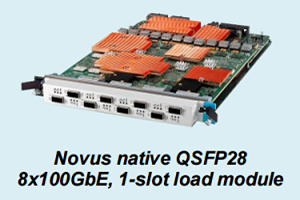
Ixia continues to set the pace in delivering production-ready solutions that enable customers to successfully deploy 100GbE, 50GbE, and 25GbE, with the introduction of the new NovusTM QSFP28 High-Density 100GbE Load Module (Novus). This new solution from Ixia increases test flexibility and reduces capital expenditure by offering multi-rate Ethernet test ports that eliminate the need to […]
Read More

The latest Intel processors support a broad range of networking workloads — including application, control, packet, and signal processing — allowing networking system designers to leverage a single architecture for a variety of different server appliances which do packet processing. Developers now can eliminate special-purpose components such as network processors (NPUs), co-processors, application specific integrated circuits (ASICs), and field-programmable gate arrays (FPGAs) used inside switches, […]
Read More

Ixia Xcellon-Multis QSFP28 Interface Load Module Optimizes Bandwidth, Reduces Expenses for Customers with Hyper-Scale Data Centers Ixia announced the latest in its history of first-to-market Ethernet speed innovations which will enable customers to successfully deploy 50GbE to meet growing bandwidth requirements as well as reduce cost and space considerations for hyper-scale data centers. Ixia’s 50GbE validation […]
Read More

25GbE helps data centers cost-efficiently accelerate application performance CALABASAS, CA — March 19, 2015 — Ixia (Nasdaq:XXIA) today announced that it will unveil the world’s first 25 Gigabit Ethernet (GbE) validation solution at the Optical Fiber Communication Conference (OFC) in Los Angeles from March 24, 2015 through March 26, 2015. Ixia’s solution—the latest in its history of […]
Read More

By Asim Rasheed, Ixia Product Management The hot word du jour in networking these days is 25 Gigabit Ethernet (GbE). Starting with data centers, this technology is fast supplanting 10GbE as the de-facto data center Ethernet technology. HOW DOES IT WORK? 25GbE uses single-lane 25Gbps link protocol that leverages existing 100GbE technology. What this means is […]
Read More

High VM-density driving an aggregation of I/O Cloud service providers and large enterprises operate server farms with ultra-high VM-density. According to a CSP survey by Infonetics, the average number of VMs per server was 42 in 2015, growing to 98 in 2017. New, powerful server processors from Intel support even more VMs and IO. QoS […]
Read More

High VM-density driving an aggregation of I/O Cloud service providers and large enterprises operate server farms with ultra-high VM-density. According to a CSP survey by Infonetics, the average number of VMs per server was 42 in 2015, growing to 98 in 2017. New, powerful server processors from Intel support even more VMs and IO. QoS […]
Read More

High VM-density driving an aggregation of I/O Cloud service providers and large enterprises operate server farms with ultra-high VM-density. According to a CSP survey by Infonetics, the average number of VMs per server was 42 in 2015, growing to 98 in 2017. New, powerful server processors from Intel support even more VMs and IO. QoS […]
Read More

High VM-density driving an aggregation of I/O Cloud service providers and large enterprises operate server farms with ultra-high VM-density. According to a CSP survey by Infonetics, the average number of VMs per server was 42 in 2015, growing to 98 in 2017. New, powerful server processors from Intel support even more VMs and IO. QoS […]
Read More

High VM-density driving an aggregation of I/O Cloud service providers and large enterprises operate server farms with ultra-high VM-density. According to a CSP survey by Infonetics, the average number of VMs per server was 42 in 2015, growing to 98 in 2017. New, powerful server processors from Intel support even more VMs and IO. QoS […]
Read More


















